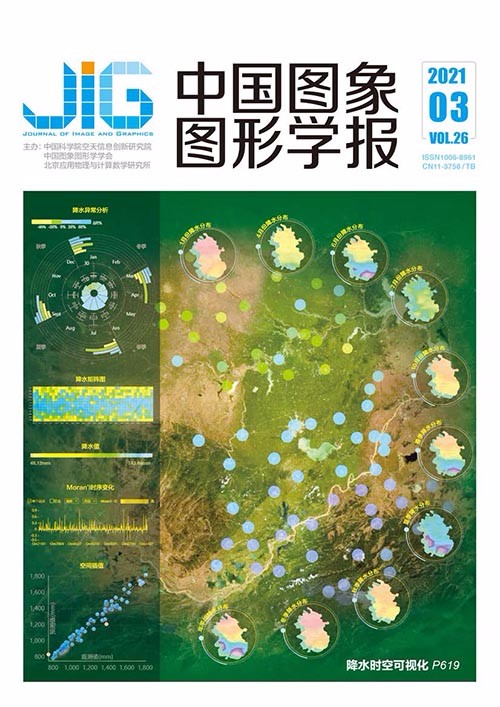
两阶段特征提取策略的图像去雾
袁非牛1,2, 李志强2, 史劲亭3, 夏雪2, 李雅2(1.上海师范大学信息与机电工程学院, 上海 201418;2.江西财经大学信息管理学院, 南昌 330013;3.江西农业大学职业师范(技术)学院, 南昌 330045) 摘 要
目的 传统以先验知识为基础的去雾算法,如最大化饱和度、暗通道等,在某些特定场景下效果非常不稳定,会出现色彩扭曲和光晕等现象。由于标注好的训练数据严重不足、特征的冗余性等原因,传统基于学习的去雾算法容易导致模型过拟合。为克服这些问题,本文提出一种基于两阶段特征提取的场景透射率回归去雾方法。方法 在第1阶段,提取图像在颜色空间上的饱和度、最小通道、最大通道以及灰度图的盖博响应等43维特征作为初始雾的特征,并在提取的特征图像局部窗口内,进一步提取最小值、最大值、均值、方差、偏度、峰度、高斯均值等7维特征。在第2阶段,将提取的43×7=301个维度特征组成表征雾的二阶段特征向量。最后采用支持向量机进行训练,得到雾的特征向量和场景透射率的回归模型。结果 实验结果表明,本文算法取得了非常好的去雾效果。平均梯度值为4.475,高于所有对比算法;峰值信噪比为18.150 dB,仅次于多尺度卷积神经网络去雾算法;结构相似性为0.867,处于较高水平;去雾后的亮度和对比度,也均排于前列。本文算法的去雾测试性能接近甚至超过了已有的基于深度学习的去雾算法,表明本文提出的两阶段特征能够很好地对雾进行表征,实现了小样本学习的高效去雾。结论 本文通过两阶段的特征提取策略,极大提升了算法的鲁棒性,仅需要极少量样本就能训练得到性能很好的去雾模型,具有很好的泛化性能。
关键词
Image defogging algorithm using a two-phase feature extraction strategy
Yuan Feiniu1,2, Li Zhiqiang2, Shi Jinting3, Xia Xue2, Li Ya2(1.College of Information, Mechanical and Electrical Engineering, Shanghai Normal University, Shanghai 201418, China;2.School of Information Technology, Jiangxi University of Finance and Economics, Nanchang 330013, China;3.Vocational School of Teachers(Technology), Jiangxi Agricultural University, Nanchang 330045, China) Abstract
Objective Haze is a very common phenomenon in nature scenes, which mainly leads to poor image quality. Image dehazing has important research significance in practical applications, such as machine vision and intelligent transportation primarily because fog reduces image contrast, resulting in instability of feature extraction methods and recognition systems. Traditional defogging algorithms based on prior knowledge, such as maximizing saturation and dark channels, have unstable effects on certain specific scenes, such as color distortion and halo. Traditional learning-based defogging methods are prone to overfitting due to lack of insufficient labeled training data and feature redundancy. Method We propose a two-phase strategy for feature extraction to improve effectiveness and representation capabilities of existing features for fog and haze by analyzing the advantages and drawbacks of existing image defogging methods. In the first phase, inspired by the successes of dark channel defogging method, similarity of Gabor filters, and human vision responses, the paper extracts color saturation, minimum color channel, maximum color channel, and Gabor responses of gray-scale images as initial fog features. Gabor filters are set to have eight orientations and five scales for a total of 40 responses of Gabor filters. Hence, the initial fog features in the first phase are 43 dimensional for each pixel. This paper extracts the minimum, maximum, mean, variance, skewness, kurtosis, and Gaussian average of each local region on every feature map of the first phase to improve the robustness of these initial features. These features are seven dimensional for each pixel of a feature map extracted in the first phase. Thus, The paper extracts 43×7=301 features in the second phase for each pixel. These features are formed as a 301-dimensional feature vector for each pixel, which has very powerful representation capabilities. Finally, we adopt support vector machine with 301-dimensional feature vectors to train a regression model between a 301-dimensional feature vector and a transmission rate. Result The paper performs experiments on several public data sets to compare our method and several image defogging methods, including deep-learning-based algorithms. Experimental results show that the algorithm in this paper achieves a very good defogging effect. For the evaluation index of average gradient, the value of this algorithm is 4.475, which is higher than all the comparison algorithms. For the peak signal-to-noise ratio, the value of the algorithm in this paper is second, with a value of 18.150 dB, second only to the multiscale convolutional neural network defogging algorithm. For structural similarity, the algorithm in this paper is 0.867, which is high. For brightness and contrast after defogging, the proposed algorithm is also in the forefront. Our method's defogging results are similar to those obtained by existing deep-learning-based defogging methods. In several cases, our results are even better than those of deep learning methods. The experimental results validate that our two-phase features can represent fog and haze. We also implement an effective image defogging method from a small labeled training dataset. Conclusion This paper can greatly enhance the robustness and representation capabilities of initial fog features, and we can use only a small training data set to train a suitable model that has very good generalization performance by using a two-phase feature extraction strategy.
Keywords
|



 中国图象图形学报 │ 京ICP备05080539号-4 │ 本系统由
中国图象图形学报 │ 京ICP备05080539号-4 │ 本系统由